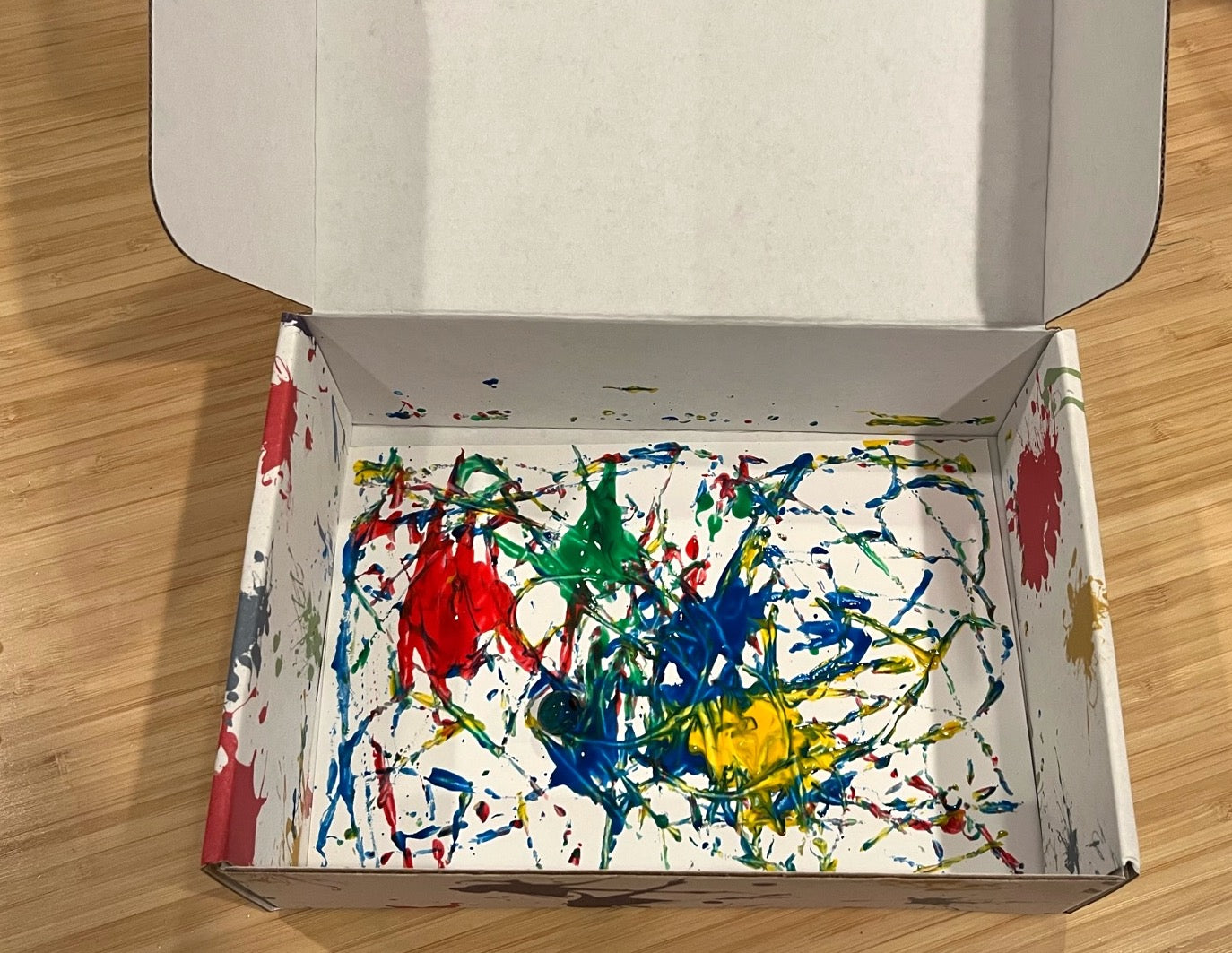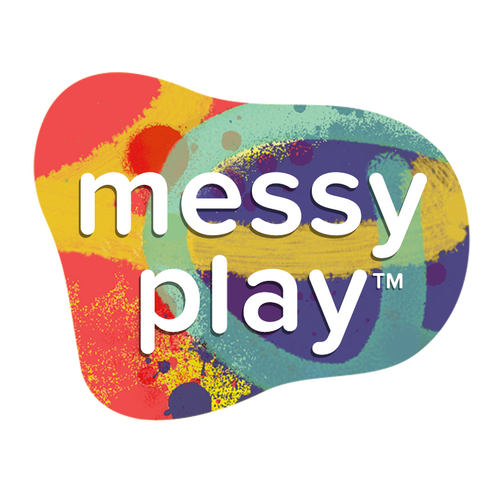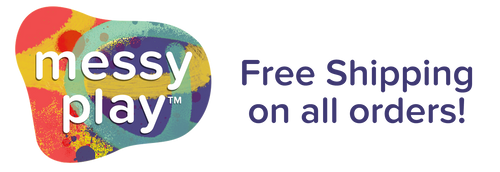

Winter Wonderland Messy Play Kit Guide
Ready to dig into your Winter Wonderland Messy Play Kit? On this page you'll find detailed step-by-step instructions, ideas to extend the learning, and some links to other resources. Feel free to reach out if you have any questions about your kit. Now go get messy!
Jump To:
Melting Snowman
Waterbeads & Tealights
Salt and Glue Snowflakes
Frozen Oobleck
Additional Resources
More Messy Play Kits
Melting Snowman:
1. Empty snowman mix into a large mixing bowl. Add 1/4 cup of water and mix thoroughly. (Note: for an extra fizzy reaction, add a squirt of dish soap!)

2. Split the dough into thirds to make 3 small snowman (or make one large snowman from the entire mix). Roll small balls of dough into body shapes and carefully stack them on a large baking tray (make sure it has an edge- the snowman will foam and fizz a lot!).

3. Decorate your snowman using the foam and pipecleaners. Bend the pipecleaners into arms and cut the foam pieces into a nose, eyes, buttons, a hat.

4. Empty the citric acid into a small bowl and mix with 1/4 cup of water until dissolved.
|
TIP: Some children become upset when something they worked hard to build gets destroyed. If your child may react like this, be sure to discuss beforehand what to expect! Gently remind them that sometimes you build things for the purpose of destroying them, and the way the snowman fizzes, foams and dissolves is quite fun! |
5. Use the pipette to squirt the citric acid onto the snowman and watch as he instantly fizzes and foams! Notice how long he takes to melt fully!




Feel the snowman as he melts- what does it feel like? This is an endothermic chemical reaction, which means it absorbs heat as it occurs. This means it will feel cold when you touch it, but only as the reaction is occurring. Before and after the fizzing, the snowman will feel room temperature (of course, this depends on the temperature of the water you added too!)
What are they learning?
- Scientific terminology/vocabulary: When you use terms like “endothermic chemical reaction” you’re introducing new vocabulary to your child. It might be more than they understand at the time but you may be surprised! They will at least understand that something is happening that they caused, which is always a powerful feeling for young children!
- Creativity: When they get to make the choices about how to shape the snowman and how to decorate him, they are using their creative brain- this leads to better problem-solving skills in adulthood! Maybe their snowman looks like a stereotypical one, or maybe it has 4 body parts instead of just 3. Let your child make those decisions as much as possible.
- Fine Motor control: Mixing the dough, squeezing the pipette, cutting the foam and decorating the snowman- these are all motions that help build fine motor control and self-help skills.
- Patience and Impulse Control: Encourage them to use the pipette instead of dumping the citric acid.
- Cause and Effect: This is a big one here! Citric acid and baking soda causes a big, fun chemical reaction that's really obvious. What a great way to learn that you can cause something new to happen by doing something so simple.
Waterbeads & Tealights:
1. Empty the bag of waterbeads into a large bowl or the bathtub. Fill the bowl with water (or fill the tub with a few inches of water).


Before you start the activity, ask your child what they think will happen. You can hint that the waterbeads will get larger, but have them predict how large they think the waterbeads will become. Write this down or have them draw pictures for the before, prediction, and after pictures. They can trace the size so it’s more accurate or use a ruler to measure.
2. In 6-8 hours the waterbeads will have absorbed the water and expanded. If you check on them during the process, you can see them start to unfold and grow!
| TIP: Take photos of the waterbeads throughout the growing process. Place something in the photo that helps show size (like your hand or a ruler). That’s a great way to see exactly how much they changed! |



3. Add more water to the bathtub, and turn on the tealights. (Note: you must open the tealights and remove the paper inside- it prevents them from turning on during shipping.)

4. Enjoy! The waterbeads are really fun to play with in water- they feel slippery and move really fast! Try catching them in your hands. Try turning off some of the overhead lights to enjoy a relaxing bath time!

| TIP: The clear waterbeads are really hard to see! For a tricky game, place them separately in a bowl of water. Ask someone what they think is in the water. Surprise them by reaching in and revealing that it’s full of waterbeads, not just water! |


| TIP: Use a colander to scoop up the waterbeads when you’re done. They are hard to catch by hand, especially the clear ones which are hard to see. They may clog the drain if they go down. |
What are they learning?
- The Scientific Process: When you ask children to make hypotheses (use that term too!) you’re encouraging them to think scientifically. You’re also showing them that science is fun, and that fun can also be scientific. They can enjoy playing with the waterbeads while thinking scientifically about them. Without overwhelming them with questions, wonder with them about what makes the waterbeads grow. Try squishing them to see what happens, and then discuss what they think the beads are made of.
- Self-esteem and validation: When you write down their thoughts, ideas and words, you validate those thoughts and show your child that what they have to say is important. Imagine how powerful that is for a small child whose world is often dominated by adult choices and decisions.
- Dramatic Play: Loosen up and enjoy the waterbeads and tealights! Pretend to be traveling through the universe and the waterbeads are stars and the tealights are suns from other galaxies. Pretend that you are a sea creature in the ocean. What other ideas for dramatic play can you and your child come up with? What do the light reflections on the walls remind you of?
Salt and Glue Snowflakes:
1. Set a piece of black paper on the art tray.
2. Pour the salt into a small bowl.
3. Now you get to make the glue snowflakes! You can squeeze the glue directly from the bottle onto the paper, or you can use a paintbrush. Snowflakes are hexagonal in shape, meaning they have 6 arms or sides. Start by drawing the basic shape of 3 intersecting lines, and then add more detail.
4. As soon as you’re done making your snowflakes (and before the glue has dried!), pour salt over all the glue on your paper, making sure you’ve covered al the glue.
5. Pick up your paper carefully, shaking the excess salt onto the art tray, and set it aside to dry. Scoop the salt back into the bowl and repeat the process with the rest of the paper, glue and salt!
|
Clean up: Let your artwork dry. More salt will come off as it dries, so shake it off over the art tray or garbage before putting it on display. The salt can be disposed of in the trash, and any extra glue can be used for other projects! |
What are they learning?
- Creativity: snowflakes come in many different shapes, even though we usually think of them being the same. There are over 80 distinct snowflake shapes! How many different designs of snowflake can you draw?
- Science: learn more about snowflakes by visiting your local library and reading about them, or looking them up on the internet. Snowflakes are ice crystals that form around dust, but ice freezes in very different ways based on the specific climate around while it’s forming. So as the snowflakes fall, the air around them is what dictates the snowflakes shape! We often draw them as symmetrical, but they really aren’t when you see them in nature.
- Fine motor control: painting with glue is tricky, especially if you’re squeezing straight from the bottle. It takes a lot of hand eye coordination and fine motor control to make an intricate snowflake design from glue.
Frozen Oobleck:
1. Empty the cornstarch into a bowl. Be careful: cornstarch is a very fine powder and poofs into the air easily!
2. Add 1/4 cup of water and mix thoroughly. You may need to add more water, but be sure to mix it in well. You should have a substance that acts as both a liquid and a solid: it clumps when you scoop it but then oozes out of your hand.
3. Play with it a bit! See what happens when you scoop it up in your hand. Make a fist and push down on the top of the Oobleck in the bowl. Push down hard with one finger, and then push gently, and see the difference.
4. Now fill the 5 plastic containers with Oobleck, put on the lids, and place them in the freezer for a few hours until solid.
5. Pop the frozen Oobleck out of the containers and place them in a bowl or bin. Play with them now- how similar is it to the room-temperature Oobleck you played with earlier?
6. Let the Oobleck melt as it comes to room temperature and continue to explore it!
|
Clean up: Oobleck can be saved in the fridge for a few days in a sealed container. When you’re done with it, toss it in the trash. Any toys or tools or bowls that had Oobleck in them should be rinsed with lots of water (to avoid making Oobleck in your drain pipes- you can imagine how that wouldn’t be good!). |
What are they learning?
- Science: Oobleck is a non-Newtonian fluid, which means it behaves as both a liquid and a solid. It’s state changes based on pressure: when you squeeze Oobleck, it’s a solid, but when it’s not under pressure it’s a liquid.
- Imagination: imagine what the world would be like if other common substances behaved like Oobleck! What if water was like that? Or your chair? Or your body?
- Sensory play: Oobleck is a really interesting texture, and not everyone enjoys it. If your child isn’t interested in touching the Oobleck with their hands, offer them tools (a spoon, a colander, a measuring cup). That way they can explore it without getting their hands messy. Sit back and let your kids play freely with the material: open-ended sensory play is great for so many aspects of development!
More Winter Play!
There are so many ways to continue playing with and learning about winter. Here are some of my favorites.
- Check out Instant Snow! If you've never played with it, it's so amazing and fun! We include it in the Arctic Sensory Bin and the Sensory Bottle Pack.
- Make your own "snow" from soap! Check out Steve Spangler Science for the instructions and the explanation of why this happens!
- For a continuation of the last experiment, use the ivory soap snow to make what Happy Hooligans calls "Ghost Mud." This looks perfect for building snowmen that won't fizz and melt!
If you liked this Messy Play Kit...
Or purchase one of these kits:


